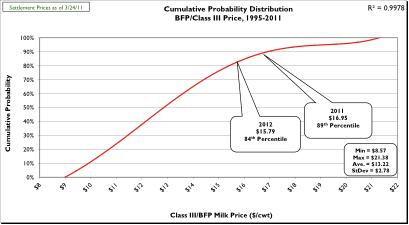Dairy Market Update, March 2011
Dairy market fundamentals and prices remain seasonally strong.
Prices: On Thursday, March 24, 2011 spot cheddar cheese blocks and barrels at the Chicago Mercantile Exchange (CME) settled at $1.6250/lb and $1.6400/lb, respectively. CME cheese prices have decreased since the middle of February (2/18/11) with blocks down $0.3300/lb and barrels down $0.2775/lb. Over the same time period the CME Class III futures averages for 2011 and 2012 both decreased; $0.10/cwt and $0.11/cwt, respectively, to $16.95/cwt and $15.79/cwt, respectively. These Class III futures averages would correspond to potential USDA Michigan mailbox prices for 2011 and 2012 of $17.94/cwt and $16.78/cwt, respectively. Since mid-February (2/18/2011) the CME spot butter price has increased slightly (+$0.0650/lb) to $2.0600/lb.
Figure 1 is a cumulative probability distribution of all USDA BFP/Class III monthly prices from 1995-present. The figure shows the current (3/24/11) CME Class III futures averages for 2011 and 2012 are at the 89th and 84th percentiles, respectively.
Figure 1: Cumulative distribution graph of USDA announced monthly BFP/Class III prices and current CME averages. (1995-present).
Supply: U.S. milk production continues to increase above trend (+1.6%, 1995-2011) with February milk production +2.0% versus February 2011. February marked the ninth consecutive month that milk production was at or above trend increase. February production in Michigan was up versus February 2010 by +2.7%. The size of the U.S. dairy herd remained the same in February compared to January at 9.160 million head, but is up 68,000 head versus February 2010. Dairy cow slaughter numbers in 2011 continue to run well ahead of last year, up 60,100 head compared to the same time frame last year (through 2/26/11). Milk production per cow in January and February were below trend increases as the USDA reported a nearly 40% increase in dairy feed prices over last year.
Demand: The USDA reports that total commercial disappearance in 2010 increased 3.1% over 2009 which is well-above the 1995-2009 average increase of 1.6% per year. All categories of wholesale dairy products showed above trend increases in disappearance for 2010 except fluid milk products. Disappearance of fluid milk products fell 1.5% in 2010, the largest decline since 1982. U.S. dairy exports remain very strong with 2010 total dairy exports valued at $3.71 billion, up 63% from 2009. U.S. dairy exports in 2010 represented a record of 12.8% of total U.S. milk production on a total solids basis. Dairy imports in 2010 were the lowest since 1997. U.S. dairy product exports in 2010 represented the following percentages of national production: NDM/SMP, 47%; dry whey, 55%; lactose, 68%; cheese, 3.7%; butterfat, 7.9%. U.S. dairy exports for January 2011 totaled $331.7 million, +49% versus January 2010. January imports was equivalent to only 2.5% of U.S. total milk production (total solids basis), the lowest in four years.
Dairy Product Inventories: The latest USDA Cold Storage Report showed inventory increases in February for American cheese (+3.9% at 622.2 million lbs.) and total cheese (+4.0% at 1,036.0 million lbs.) compared to February 2010. Both cheese inventories set all-time February highs, but were the lowest increases versus the same month in the previous year in many months (American cheese, June 2009; total cheese, November 2008). February butter inventory was 31.7% below February 2010, which marked the fourteenth consecutive month butter inventory has been below the same month last year.
Outlook: Even though most wholesale dairy product prices have recently declined, along with CME Class III futures, it is normal for this time of year. April through June marks the spring flush of milk production in the U.S. which typically results in the lowest dairy product and milk prices of the year. However, all dairy product wholesale prices and milk class prices should remain well-above historical averages for all of 2011. High feed and record cull cow prices should limit the growth of the U.S. dairy herd in 2011. As long as the U.S. dairy export market retains its current strength, dairy producers will be rewarded with milk prices above historical averages. The current CME Class III futures average ($16.95/cwt) for 2011 is nearly at the 90th percentile of historical Class III prices (1995-present). This means that only about 10% of the time from 1995-present has any monthly actual Class III price been higher than $16.95/cwt. With prices at these levels dairy producers should consider using price risk management tools (e.g., futures contracts, forward contracts, put options) to market some of their 2011 milk production and reduce their exposure to milk price risk. Producers should calculate their latest cost of production and market milk in proportion to their risk attitude and degree of overall financial risk. Producers should also remember that milk marketing is about price risk management first and profit enhancement is only a secondary consideration.



 Print
Print Email
Email


